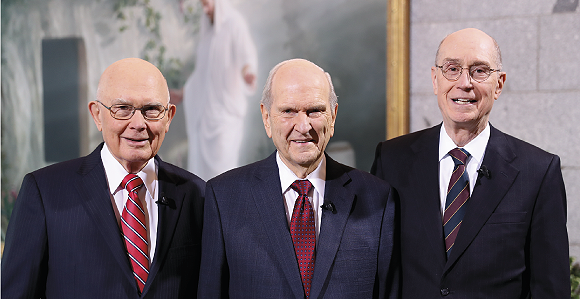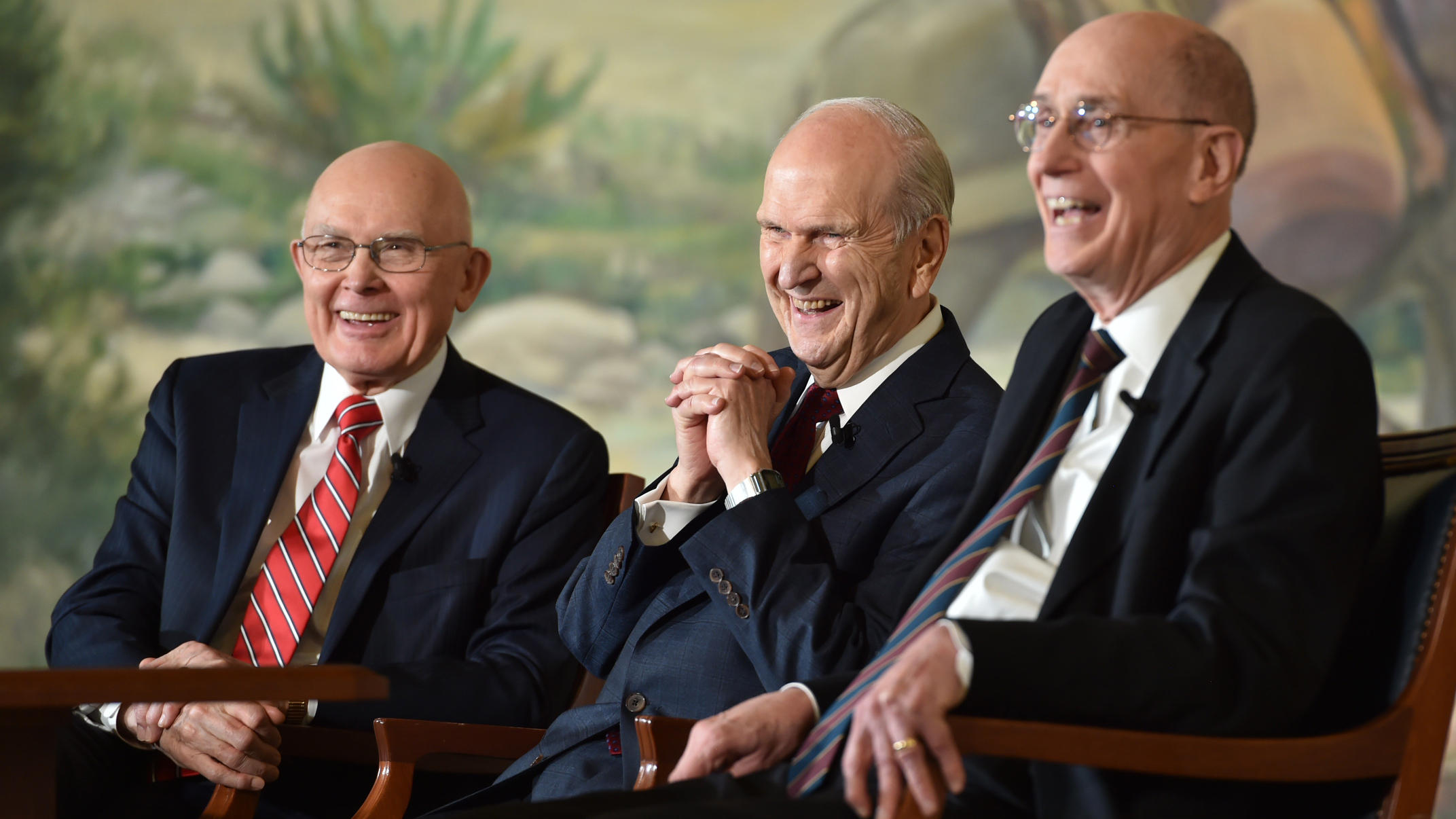Difference between revisions of "First Presidency"
m |
m |
||
| Line 4: | Line 4: | ||
==Membership== | ==Membership== | ||
| − | [[Image:First_Presidency_2018.jpg|left|frame| | + | [[Image:First_Presidency_2018.jpg|left|frame|10px|(left to right) [[Dallin H. Oaks]], [[Russell M. Nelson]], and [[Henry B. Eyring]] © Intellectual Reserve]] |
The First Presidency is composed of the [[President of the Church]] and his counselors. Most First Presidencies have been composed of the president and two counselors, but circumstances have occasionally required additional ones (for example, [[David O. McKay]] had five during the final years of his presidency and at one point [[Brigham Young]] had eight). | The First Presidency is composed of the [[President of the Church]] and his counselors. Most First Presidencies have been composed of the president and two counselors, but circumstances have occasionally required additional ones (for example, [[David O. McKay]] had five during the final years of his presidency and at one point [[Brigham Young]] had eight). | ||
Revision as of 07:10, 18 January 2018
The First Presidency (also called the Quorum of the Presidency of the Church or simply the Presidency) is the presiding or governing body of The Church of Jesus Christ of Latter-day Saints (LDS Church). It is composed of the President of the Church and his counselors. The First Presidency currently consists of Russell M. Nelson and his two counselors, Dallin H. Oaks and Henry B. Eyring.
Contents
Membership
The First Presidency is composed of the President of the Church and his counselors. Most First Presidencies have been composed of the president and two counselors, but circumstances have occasionally required additional ones (for example, David O. McKay had five during the final years of his presidency and at one point Brigham Young had eight).
Counselors are usually chosen from among the members of the Quorum of the Twelve Apostles, although there have been a number of exceptions where members of the church's Presiding Bishopric or the church at large were called to be counselors. Any High Priest of the church is eligible to be called as a counselor in the First Presidency. There have also been a few cases where counselors have been ordained to the priesthood office of apostle and became members of the Quorum of the Twelve after already being set apart as counselors in the First Presidency (e.g., J. Reuben Clark). There have been other cases where counselors have been ordained to the office of apostle but not set apart as a member of the Quorum of the Twelve (e.g., Alvin R. Dyer). Other counselors in the First Presidency were never ordained to the office of apostle (e.g., Charles W. Nibley; John R. Winder). Whether or not a counselor is an apostle, all members of the First Presidency are sustained by the church as prophets, seers, and revelators.
Counselors are formally designated as "First Counselor in the First Presidency" and "Second Counselor in the First Presidency" based on the order they were selected by the president. Additional counselors have been designated in different ways, including "Third Counselor in the First Presidency" (e.g., Hugh B. Brown), "Assistant Counselor to the President" (e.g., John Willard Young), and simply "Counselor in the First Presidency" (e.g., Thorpe B. Isaacson).
Counselors serve in the First Presidency until their own deaths, until the death of the church president who called them, or until they are released by the church president. The death of a church president dissolves the First Presidency, and leaves the President of the Quorum of the Twelve Apostles as the senior leader of the church. The death or release of a counselor does not dissolve the First Presidency.
Often, the surviving counselors of the late president will be called as counselors in the new First Presidency, and a notably infirm counselor may revert to his place among the Twelve Apostles with a healthier man called as counselor in his place. On the death or release of a first counselor, the second counselor usually succeeds and a new second counselor is named. Although these are fairly common occurrences, there are no hard and fast rules about such practices and each president is free to choose the counselors he prefers. See Counselors Not Retained, below.
Title of members
Like the church president and President of the Quorum of the Twelve Apostles, counselors in the First Presidency are appropriately referred to by the title "President".
Duties
- Main article: President of the Church
The First Presidency is the highest ranking priesthood quorum of the church. The counselors assist the church president and work closely with him in guiding the entire church and carrying out the duties of the president of the church. The First Presidency has the theoretical authority to make the final decision on nearly all issues which might affect the church or its operations, though in practice the First Presidency has delegated much of its decision-making power to members of the Quorum of the Twelve Apostles, the Seventy, the Presiding Bishopric, and local leaders of the church. Nevertheless, the First Presidency has retained its overarching decision-making power in a number of significant areas and may at any time choose to overrule the decisions of a lesser church quorum or authority.
In the case of an infirm president, his counselors may be called upon to perform more of the duties of the First Presidency that would normally be performed by the president. If needed, any number of additional counselors may be called to assist them, though the president of the church remains the only person on the earth authorized to use all priesthood keys. All members of the First Presidency are sustained by the membership of the church as prophets, seers, and revelators.
All members of the First Presidency are also members of the church's Council on the Disposition of the Tithes, a body which determines how the tithing funds of the church are spent.
Current First Presidency
The current First Presidency was announced on 16 January 2018. The president, Russell M. Nelson, and his counselors, Dallin H. Oaks and Henry B. Eyring, were sustained by the Quorum of the Twelve Apostles on Sunday, 14 January 2018.
The previous First Presidency was dissolved on 2 January 2018 upon the death of church president Thomas S. Monson.
Members of the First Presidency who were not Apostles
There is no requirement that counselors in the First Presidency be apostles of the church. The following men served as a counselor in the First Presidency during the years indicated and were never ordained to the priesthood office of Apostle:
- Sidney Rigdon (1832–1844)
- Jesse Gause (1832–1833)
- Frederick G. Williams (1833–1837)
- John Smith (1837–1844)
- Joseph Smith, Sr. (1837–1840)
- William Law (1841–1844)
- John C. Bennett (1841–1842)
- John R. Winder (1901–1910)
- Charles W. Nibley (1925–1931)
- Thorpe B. Isaacson (1965–1970)
Counselors in the First Presidency not retained upon reorganization
- John Smith, Assistant Counselor to Joseph Smith, Jr., not retained as a counselor by Brigham Young
- Amasa M. Lyman, Assistant Counselor to Joseph Smith, Jr., not retained as a counselor by Brigham Young
- John Willard Young, First Counselor to Brigham Young, not retained as a counselor by John Taylor
- Daniel H. Wells, Second Counselor to Brigham Young, not retained as a counselor by John Taylor
- Brigham Young, Jr., Lorenzo Snow, and Albert Carrington, Assistant Counselors to Brigham Young, not retained as a counselor by John Taylor
- Rudger Clawson, called as Second Counselor to Lorenzo Snow, not retained as a counselor by Joseph F. Smith
- Hugh B. Brown, First Counselor to David O. McKay, not retained as a counselor by Joseph Fielding Smith
- Thorpe B. Isaacson and Alvin R. Dyer, Counselors to David O. McKay, not retained as counselors by Joseph Fielding Smith
- Marion G. Romney, First Counselor to Spencer W. Kimball, not retained as a counselor by Ezra Taft Benson
- Dieter F. Uchtdorf, Second Counselor to Thomas S. Monson, not retained as counselor by Russell M. Nelson
Secretary to the First Presidency
The church employs a secretary to assist the First Presidency in its administrative duties. The position is paid employment and its holder is not formally considered to be a member of the First Presidency or a general authority of the church. However, it is common for letters from the office of the First Presidency to private individuals to bear the signature of the Presidency's secretary as opposed to any of the members of the Presidency.
The First Presidency also employs assistant secretaries and press secretaries. When David O. McKay became President of the Church in 1951, he continued with his longtime personal secretary, Clare Middlemiss, and moved the existing secretary, Joseph Anderson, into the newly created First Presidency's office.[1] D. Arthur Haycock also served as personal secretary to several church presidents in the 20th century.
Chronology of secretaries
- George W. Robinson (1838–1840)
- George Reynolds (1865–1909)
- George F. Gibbs (1909–1922)
- Joseph Anderson (1922–1970)
- Francis M. Gibbons (1970–1986)
- F. Michael Watson (1986–2008)
- Brook P. Hales (2008– )
Notes
- ↑ Prince, Gregory A.; William Robert Wright (2005). David O. McKay and the Rise of Modern Mormonism. University of Utah Press. p. 407. ISBN 978-0-87480-822-3. Retrieved 2009-07-17.

